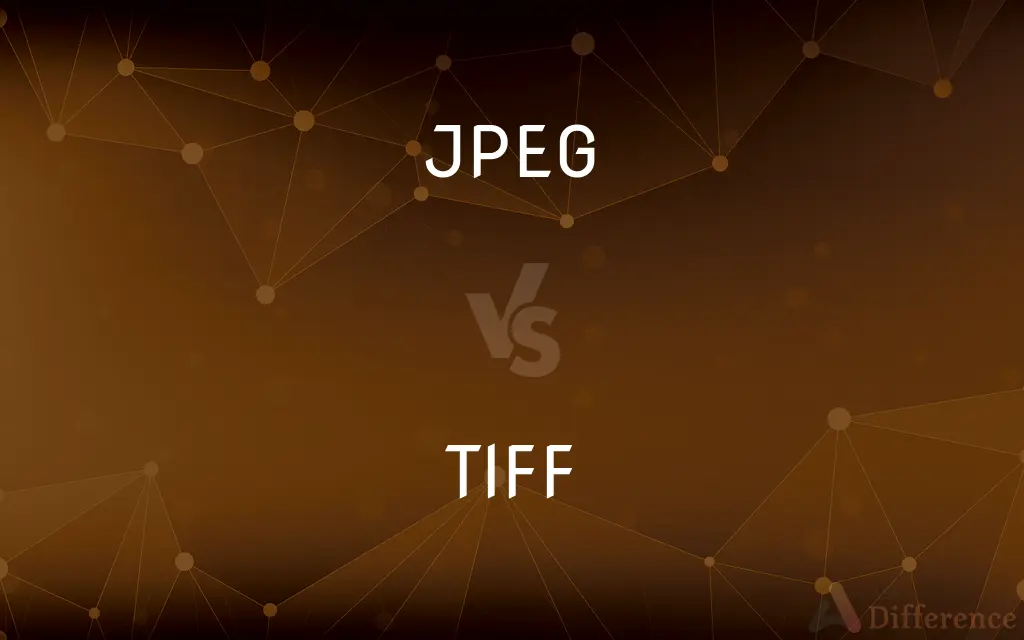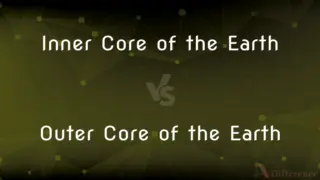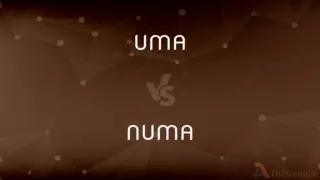JPEG vs. TIFF — What's the Difference?
By Tayyaba Rehman & Urooj Arif — Published on January 31, 2024
JPEG is a commonly used lossy compression format for digital images, especially for those with color gradients. TIFF is a flexible, adaptable format often used for high-quality graphics.

Difference Between JPEG and TIFF
Table of Contents
ADVERTISEMENT
Key Differences
JPEG, or Joint Photographic Experts Group, is a popular image format known for its efficient compression and small file sizes. TIFF, or Tagged Image File Format, offers higher quality with support for multiple layers and pages, making it larger in size.
JPEG images use lossy compression, losing some image quality for smaller file size, which makes it ideal for web use. TIFF uses lossless compression or no compression, retaining higher image quality, suited for editing and printing.
JPEG is widely used in digital photography and online images due to its balance of quality and file size. TIFF is preferred in professional photography, graphic design, and publishing for its high fidelity and detailed image storage.
The JPEG format is not ideal for images requiring multiple editing sessions due to its lossy nature, which can degrade quality over time. TIFF files are better for extensive editing, as they don't lose quality with each save.
JPEG does not support transparency, which limits its use in certain graphic design applications. TIFF, however, supports transparency, making it more versatile for layered graphic compositions.
ADVERTISEMENT
Comparison Chart
Compression Type
Lossy
Lossless or None
File Size
Smaller, more compressed
Larger, less or no compression
Image Quality
Good for web, loses quality over edits
High, maintains quality over edits
Usage
Web, digital photography
Professional photography, printing
Transparency Support
No
Yes
Compare with Definitions
JPEG
An image format not suitable for transparency.
He couldn't use JPEG for his graphic design because it doesn't support transparency.
TIFF
A versatile image format supporting lossless compression.
The scanned document was saved as a TIFF for maximum clarity.
JPEG
Standard format for compressing photographic images.
Most images on the web are in JPEG format.
TIFF
Format often used in professional photography and printing.
For the print ad, they requested the image in TIFF format.
JPEG
A digital image format with lossy compression.
He saved the photo as a JPEG to reduce the file size.
TIFF
Suitable for images requiring multiple edits without quality loss.
She saved her artwork as a TIFF to avoid degradation over edits.
JPEG
Popular format for digital cameras and online sharing.
Her camera saves pictures in JPEG format by default.
TIFF
A format that supports transparency for complex graphics.
TIFF was her choice for the layered design because it supports transparency.
JPEG
A format offering a balance of image quality and compression.
For her blog, she used JPEG images for faster loading.
TIFF
An image format supporting layers and high quality.
TIFF format was perfect for his detailed graphic illustration.
JPEG
A standard algorithm for the compression of digital images.
TIFF
A fit of irritation.
JPEG
A digital image stored as a file so compressed
A JPEG of a cat.
TIFF
A petty quarrel.
JPEG
Alternative case form of JPEG
TIFF
To quarrel.
JPEG
A standardized format for storing graphic data in binary computer files, allowing over 16 million different colors. It allows for lossy compression, i. e. the compression of data into a form which re-expands into an image close, but not identical to the original image. Files stored in this format usually carry the extension jpg or jpeg. Compare GIF.
TIFF
A small argument; a petty quarrel.
TIFF
Liquor; especially, a small draught of liquor.
TIFF
(intransitive) To quarrel.
TIFF
To deck out; to dress.
TIFF
Liquor; especially, a small draught of liquor.
TIFF
A fit of anger or peevishness; a slight altercation or contention. See Tift.
TIFF
To be in a pet.
She tiffed with Tim, she ran from Ralph.
TIFF
To deck out; to dress.
TIFF
A quarrel about petty points
Common Curiosities
Is TIFF suitable for web graphics?
TIFF is not typically used for web due to its larger file size.
Does JPEG support transparency?
No, JPEG does not support transparency.
What is JPEG best used for?
JPEG is best for web images and digital photography where file size is a concern.
Can TIFF files store multiple layers?
Yes, TIFF can store multiple layers and pages.
Should I use JPEG for online images?
Yes, JPEG is preferred for online images due to its balance of quality and file size.
Is TIFF good for printing?
Yes, TIFF's high quality makes it ideal for printing.
Is TIFF a good choice for archival purposes?
Yes, due to its high quality and lossless compression, TIFF is good for archiving.
Are JPEG files smaller than TIFF?
Yes, JPEG files are generally smaller due to lossy compression.
Can JPEG images lose quality over time?
Yes, JPEGs can lose quality with repeated editing and saving.
Why is TIFF preferred in professional settings?
TIFF maintains high image quality, which is crucial in professional settings.
Does JPEG support animation?
No, JPEG does not support animation.
Are JPEG images faster to load?
Yes, their smaller size makes JPEG images faster to load.
Can TIFF handle detailed graphics better than JPEG?
Yes, TIFF's lossless compression is better for detailed graphics.
Is JPEG widely supported across platforms?
Yes, JPEG is one of the most widely supported image formats.
Can TIFF be used for extensive editing?
Yes, TIFF is suitable for extensive editing without quality loss.
Share Your Discovery

Previous Comparison
Inner Core of the Earth vs. Outer Core of the Earth
Next Comparison
UMA vs. NUMAAuthor Spotlight
Written by
Tayyaba RehmanTayyaba Rehman is a distinguished writer, currently serving as a primary contributor to askdifference.com. As a researcher in semantics and etymology, Tayyaba's passion for the complexity of languages and their distinctions has found a perfect home on the platform. Tayyaba delves into the intricacies of language, distinguishing between commonly confused words and phrases, thereby providing clarity for readers worldwide.
Co-written by
Urooj ArifUrooj is a skilled content writer at Ask Difference, known for her exceptional ability to simplify complex topics into engaging and informative content. With a passion for research and a flair for clear, concise writing, she consistently delivers articles that resonate with our diverse audience.













































